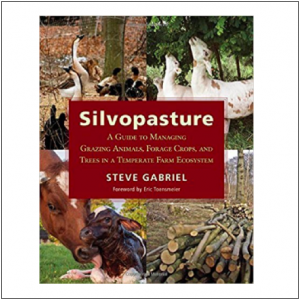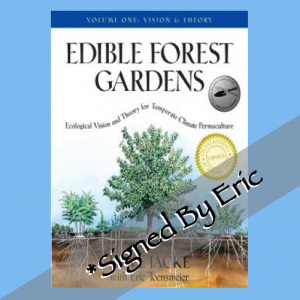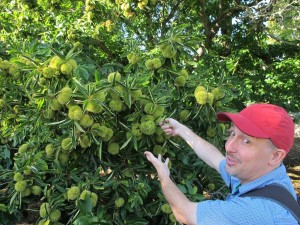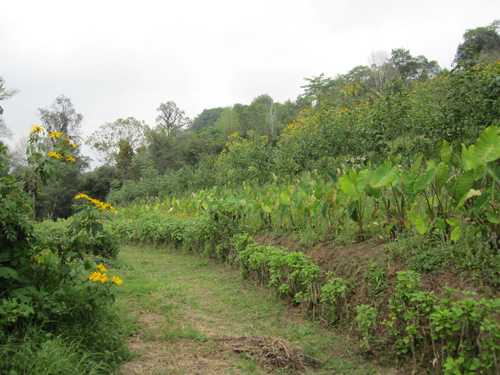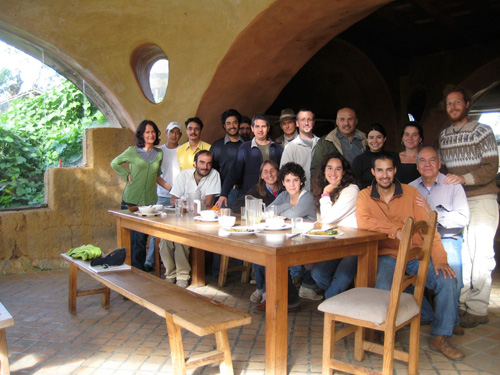When I visit tropical and subtropical forest gardens I often see ginger, turmeric, galangal, and cardamom in the understory, beneath and between the fruit trees. In fact, according to P.K. Nair’s fantastic Tropical Homegardens, ginger and turmeric are universally found in tropical homegardens (ancient, traditional food forests) around the world.

I was thus very excited the day my copy of T.M.E. Branney’s Hardy Gingers arrived in the mail. This book profiles perhaps 100 members of the ginger family (Zingiberaceae) and the related Costaceae. How nice to learn that many, many gingers can handle some cold, and are grown by gardeners in the US and UK as ornamentals.
Hardy Gingers also lists uses for many of these species. I went further and cross-referenced with Kunkel’s Plants for Human Consumption (listing 18,000 edible plants) and Mansfield’s Encyclopedia of Agricultural and Horticultural Crops (6,000 cultivated crops) and came up with a list of edible gingers for temperate climates.

I garden in USDA zone 6 (-10F, -23C), and have a protected area for more tender species. Last year I planted three edible hardy gingers there: mioga ginger (Zingiber mioga), with edible shoots and roots; butterfly ginger (Hedychium coronarium), with beautiful edible flowers; and zedoary (Curcuma zedoaria), a species of which almost every part is used as a spice. Currently I’m waiting for the snow to melt to see which ones survived. Plant Delights nursery taught me that you have to personally kill something three times before you know it won’t grow for you, so I’m on my way.

The uses of these crops fall into several categories:
- Rhizomes. These are spicy roots used like ginger, turmeric, and galangal.
- Starch. Some Curcuma roots are cultivated for extraction of starch (like Queensland arrowroot or kudzu).
- Shoots. Eaten like asparagus. This is a major use of true ginger and mioga ginger.
- Leaf. Some are used to wrap foods while cooking to add flavor, others are directly used as a spice.
- Flower spikes. Eaten as a spicy vegetable.
- Flowers. Edible spicy flowers.
- Bulbils. Small spicy roots that grow on the flower head of Globba species.
- Fruits, seeds. These are used like cardamom.

Food foresters in warm (and cool) temperate climates might be interested in planting members of this useful and ornamental family of plants in their understory. Many hardy gingers are quite shade tolerant. The table below presents the results of my cross-indexing of Hardy Gingers with Kunkel and Mansfeld. You’ll notice that turmeric, galangal, and even true ginger grow beyond the subtropics. Pick up a copy of Hardy Gingers to learn more about cultivating this interesting group of plants.
| Latin Name | USDA Zone | Minimum Temp. | Light | Edible Uses |
| Alpinia caerulea | 8 | 20 F/-6 C | sun | fruit, root tips, leaves, flowers |
| A. galanga | 7 | 10 F/ -12C | part shade | cultivated galangal: for roots, flowers, spicy fruits, leaves |
| A. japonica | 7 | 10 F/-12C | part shade | fruits |
| A. nutans | 8 | 15 F/ -9C | part to shade | fruits like cardamom |
| A. zerumbet | 7 | 0 F/ -17C | sun to part | leaves as food wrapper, shoot tips, rhizomes, flowers |
| Amomum dealbatum | 8 | 15 F/-9C | part shade | seeds, flower spikes |
| A. subulatum | 8 | 15 F/-9C | part to shade | seed pods cultivated as “black cardamom” |
| Bosenbergia rotunda | 8 | 15 F/-9C | shade | cultivated for spicy roots, also shoots and leaves |
| Costus speciosus | 7 | 0 F/-17C | part shade | shoots edible, rhizome |
| C. spiralis | 9 | 25 F/ -3F | part shade | young leaves |
| Curcuma alismatifolia | 8 | 15 F/-9C | sun to part | flowers |
| C. amada | 9 | 20 F/-6 C | sun to part | rhizomes, cultivated |
| C. angustifolia | 8 | 15 F/-9C | sun to part | cultivated for starch extracted from rhizomes, also flower spikes |
| C. aromatica | 7 | 10 F/-12C | sun to part | starch extracted from rhizomes |
| C. aurantiaca | 9 | 22 F/ -5C | sun to part | young flower spikes |
| C. longa | 7 | 5 F/ -15C | sun to part | cultivated turmeric, rhizomes used fresh or dried, young shoots, leaves |
| C. petiolata | 7 | 5 F/-15C | sun to part | “used as a spice” |
| C. rubescens | 7 | 5 F/-15C | sun to part | starch extracted from rhizomes |
| C. zedoaria | 7 | 5 F/-15C | sun to part | cultivated for starch extracted from rhizomes, also shoot hearts, flower spikes, leaves, young rhizomes eaten |
| Globba globulifera | 9 | 20 F/-6 C | part to shade | spicy aerial bulbils |
| G. racemosa | 8 | 15 F/-9C | part to shade | spicy aerial bulbils |
| G. schambergkii | 8 | 15 F/-9C | part to shade | spicy aerial bulbils |
| Hedychium coronarium | 7 | 5 F/-15C | sun to part | flowers and flowerbuds |
| H. gracile | 8 | 15 F/-9C | part shade | “used as a spice” |
| H. spicatum | 7 | 5 F/-15C | part shade | fruits, dried rhizome |
| Kaempferia galanga | 8 | 15 F/-9C | part to shade | cultivated for leaves, rhizome |
| K. rotunda | 8 | 15 F/-9C | part to shade | cultivated for leaves, rhizome, shoots |
| Zingiber cassumunar | 8 | 15 F/-9C | part shade | flower spikes, rhizome |
| Z. mioga | 6 | -10 F/ -23C | part to shade | cultivated for shoots, also rhizome, leaves, flower spikes |
| Z. officinale | 8 | 15 F/-9C | sun to part | cultivated ginger, rhizome and shoots |
| Z. rubens | 7 | 10 F/-12C | part shade | seedpods |
| Z. spectabile | 9 | 20 F/-6 C | part shade | “flavoring” |
| Z. zerumbet | 8 | 15 F/-9C | part shade | rhizomes, shoots |
Here are a few sources for hardy gingers:
These are all in the UK or USA.

